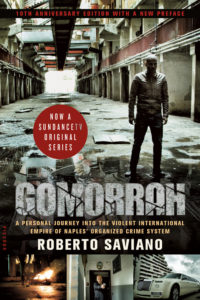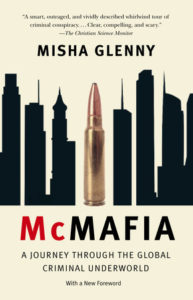Like most people, I’d never heard of the Calabrian mafia, the ‘Ndrangheta, until I came across the story of The Good Mothers, quite by accident, while reporting another story in Italy. Once I started researching the group, it quickly became clear what a giant gap existed in my knowledge–not just of organized crime but, really, in how the world works.
The ’Ndrangheta turned out to be, by almost any measure, the most powerful mafia in the world. They make somewhere between $50-100 billion a year, or 3.5% of Italian GDP. They have a daily effect on the lives of millions or even billions of people, smuggling 70% cocaine in Europe, supplying weapons to all sides in the Syrian civil war, embezzling billions from the European Union and even dumping nuclear waste in the sea off East Africa. As one of the biggest money launderers on the planet, washing not only their own wealth but also that of other mafias from Asia, Africa and the Americas, they move markets and change lives in more than 100 countries around the world. Millions of us live in their buildings, work in their companies, eat in their restaurants, trade in their shares and elect politicians they fund. That almost no one outside a small group of Italian anti-mafia prosecutors, policemen and journalists knows about them is unnerving–and also, I came to understand, a testament to their intimidating professionalism. A central reason why the ’Ndrangheta are as big and powerful as they are is because no one has ever heard of them.
I spent a sizable amount of the two and a half years that it took to report and write The Good Mothers attempting to correct my ignorance. Most of my research on the ’Ndrangheta came direct from the source: prosecutor documents detailing their painstaking uncovering over several decades of one of the world’s great criminal conspiracies. But beyond the ’Ndrangheta, many academics, journalists, travel writers and novelists have written about the wider Italian mafia and international organized crime, and in doing so have produced some of the very best journalism and non-fiction in existence. The following is my selection from that elevated list.
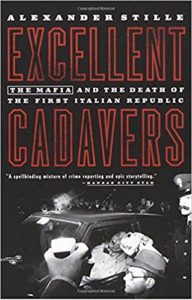
Excellent Cadavers, Alexander Stille
The definitive account of how a small group of Sicilian prosecutors took on the island’s mafia in the 1980s and 1990s. The prosecutors exposed Cosa Nostra not as a myth or legend but a global criminal enterprise headquartered in Sicily, with an extraordinary reach inside the Italian government—and set about cutting them down to size. Some paid the ultimate price, including the legendary prosecutors Giovanni Falcone and Paolo Borsellino, killed in bomb attacks within two months of each other in 1992. But eventually Cosa Nostra was humbled, and its political protectors and a generation of bosses jailed. Stille’s skillful story-telling and clear, precise, compelling writing are an example to any non-fiction writer.
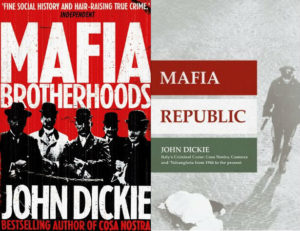
Mafia Brotherhoods (Blood Brotherhoods) and Mafia Republic, John Dickie
It is a measure of the British historian Dickie’s standing among mafia experts that his two accounts of the Italian mafia are standard texts even for native Italians. Brotherhoods recounts the emergence of the three main Italian mafias—the Camorra in Naples, Cosa Nostra in Sicily and the ’Ndrangheta in Calabria—in the mid to late 19th century up to the end of World War II. Republic deals with the period since then and the Italian state’s efforts to fight organized crime. Dickie combines scholastic precision with an accessible writing style and an eye for jaw-dropping detail. He’s also generous with his knowledge. Dickie was kind enough to let me interview him for The Good Mothers and to fact-check part of the text.
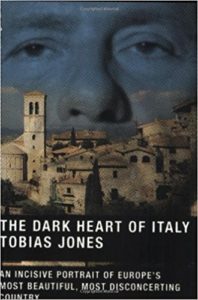
The Dark Heart of Italy, Tobias Jones
Jones lived in Italy for several years while he reported and wrote this exploration of modern Italy. Though the book is fifteen years old now, its insights still feel fresh, both in explaining Italy and the present rise of populism. Jones discerned that the great tragedy of Italy is the vortex of uncertainty, suspicion and deceit that replaced the civil contract in the nation’s heart. When everyone suspects everyone, and certainty and truth is lost, charlatan politicians and organized crime find it easy to take over. Jones also introduced me to the word ‘furbo’—someone who pretends to be your friend when they’re really not—which helped me understand some of the characters I encountered during the reporting of The Good Mothers.
Gomorrah, Roberto Saviano
Saviano is not as appreciated at home as he is overseas; there are persistent grumblings from his Italian contemporaries about accuracy and fabulism. But nothing can take away either from the breath-taking subterfuge it took to write this book—working in mob-controlled factories, as a waiter at a mob wedding and in mob businesses in Aberdeen, Scotland—or the impact it had. No single work has done more to correct the image of the mafia and dispel the glamour it so assiduously cultivated. No journalist has had more success in bringing attention to the financial world’s complicity in criminality, particularly London. A game changer.
McMafia, Misha Glenny
Misha Glenny’s sweep of the world’s mafias, and how they rode the wave of globalization like legitimate business, is the basis of a compelling BBC drama series of the same name. But it is the original 2008 book that still blows me away. Very few journalists have penetrated so deeply into organized crime. And while plenty of people (including me) have written about the pitfalls of globalization, Glenny was the first to zero in on how it was the driving force behind the world’s growing criminalization. Today I’m beginning to sense a growing recognition of the reality that Glenny first revealed: that terrorism, such a preoccupation, is a distraction from the rise of organized crime, which is what is really changing the world.

Mafia Life, Federico Varese
Varese is a fascinating combination of academic and relentless on-the-ground observer who has done a better job than any writer alive at penetrating and even befriending mafiosi around the world. Mafia Life pulls together decades of Varese’s experiences into a series of disarming portraits and vignettes that delve into the private worries and banal every day of gangsters. Varese’s relationship with one of his subjects is so close that he received a small carved statue from him, sent from prison for Christmas. Enlightening.

Gangster Warlords and El Narco, Ioan Grillo
Grillo is our pre-eminent observer of Latin American drug cartels. Combining history, unparalleled contacts and excruciating reporting, Grillo, a British journalist based in Mexico for fifteen years, offers a comprehensive account of the past and present of the cocaine trade and how its corruption and violence devastated several nations. Anyone who imagines cocaine as fashionable or harmless should read Grillo. The long list of journalists executed by the cartels only make his work more courageous and more necessary.
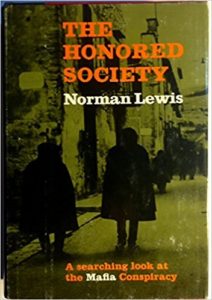
The Honored Society, Norman Lewis
Originally published in 1964, Lewis’ account of the origins of the Sicilian mafia and how they were integral to the Allies’ lightning advance across the island in 1943 remains a masterpiece of both mafia history and narrative journalism. There are many myths that surround the mafia’s part in the war, many spun by mafiosi themselves. Lewis’s interviews cuts through to the truth: that for Cosa Nostra, World War II was essentially the opportunity for a power grab.

The Godfather, Mario Puzo
Though it references real-life dynamics and events, Puzo’s book is a pulp thriller. Most anti-mafia magistrates hate it, and the films based on it, for lending mafiosi the kind of folkloric allure of which they had previously only dreamed—and they have a point. But Puzo also understood something about people’s relationship with truth. If myths are to be believed, it can help if they are true. But far more important is that they are entertaining.

’Ndrangheta, Anna Sergi and Anita Lavorgna
Two Italian women criminologists based in England deliver the most comprehensive and detailed summary of the world’s most powerful mafia in 122 meticulously sourced pages. There is not much in the way of narrative or story here. Rather, this is a precisely accurate briefing from two of those most qualified to give one. Everything you wanted to know about the ’Ndrangheta, and plenty you will wish is not true, in one slim volume.


